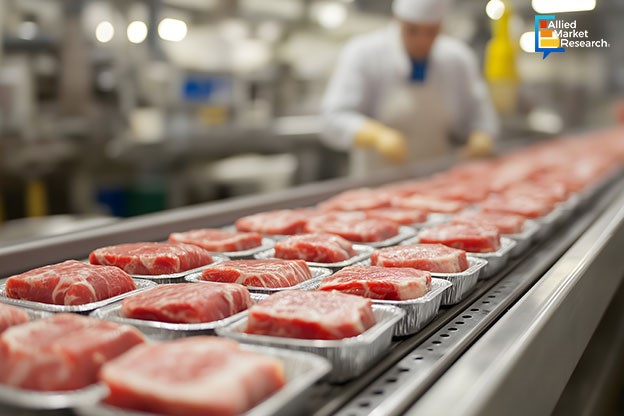Meat Processing Equipment: Integration of Automation and AI Creating Profitable Opportunities

7 Apr
2025
Key takeaways:
- Introduction
- Innovations in the meat processing equipment sector
- Mergers and acquisitions in the industry
Over the years, the changing lifestyles and dietary habits of people living in urban areas have increased the consumption of packaged food items such as processed and frozen meat products. Moreover, the rising disposable incomes of almost all sections of the global population have positively impacted the meat and poultry sector. Additionally, the increased awareness regarding the importance of nutrition and immunity building has led to a growth in the intake of protein-rich items like eggs, chicken, pork, beef, and fish. Several food and beverage companies have started investing in modern meat processing equipment and techniques to address the evolving needs of their consumer base, thereby increasing their footprint in the industry.
Advancements in meat processing equipment helping the industry flourish
The meat processing equipment industry accounted for $6.3 billion in 2023 and is predicted to gather a sum of $13.6 billion by 2034, citing a CAGR of 7.4% during 2024-2034. The innovations and technological advancements in meat processing equipment have accelerated sectoral growth in recent times. Typically, tools and machines are used for slaughtering, cutting, grinding, and slicing meat, which is then turned into various products like sausages, patties, and salami slices. In the last few years, sharp and durable meat knives and blades made from high-quality stainless steel have been developed. Additionally, these tools are now coated with unique materials such as diamond-like carbon (DLC), Teflon, and titanium nitride to reduce wear and tear.
Along with this, the introduction of automation systems and robotics has played an important role in the growth of the industry in the last few years. Many leading poultry companies have started deploying these solutions to increase their production and boost their revenue share. Automation tools, for instance, help businesses perform various repetitive tasks with high accuracy, thus minimizing the need for human intervention in these processes. As a result, manual labor can be employed in more productive tasks, thereby enhancing the overall efficiency of the company. Moreover, robots also aid in packaging tasks by handling activities related to sealing, labeling, boxing, and delivering the products. Recently, PMMI, The Association for Packaging and Processing Technologies, conducted a survey in which around 50% of the leading packaging companies considered automation as one of the most important trends in the industry.
On the other hand, the emergence of AI, data analytics, and IoT has opened new investment avenues in the sector. AI-based meat processing equipment and machine learning algorithms are used by companies to identify and segregate meat products of different cuts, thus simplifying their operations significantly. Moreover, IoT-powered sensors are also utilized to check the quality of the meat products that are being packaged, thus increasing overall food safety.
M&A deals among leading industry participants augmenting the market’s growth rate
Apart from the technological advancements, the strategic alliances among the major companies have strengthened the position of the sector in the last few years. In July 2024, for example, Fortifi Food Processing Solutions, a machinery industry company, announced the acquisition of LIMA (Les Innovations Mecaniques Alimentaires), a meat processing equipment manufacturer based in France. Established in 1981, LIMA gradually became one of the biggest players in the industry, making this deal a major market development in recent times. The business move is expected to expand the portfolio of Fortifi Food Processing Solutions significantly, helping the company increase its footprint globally.
Similarly, in January 2025, Marel, an Icelandic meat processing company, issued a press release reporting the acquisition of John Bean Technologies Corporation, a food processing machinery developer. The new firm which has been renamed as JBT Marel Corporation has announced its intention to invest heavily in digital technologies and modernize its supply chain operations to cater to the demands of its consumer base comprehensively.
In summary, the changing consumption patterns and the rising disposable incomes of people in metropolitan cities and urban areas have led to a growth in the demand for processed and frozen meat products. Additionally, the integration of various digital technologies such as robotics, AI, and IoT is predicted to create favorable conditions for the expansion of the meat processing equipment industry in the future.
Get in touch with our experts for the latest trends and advancements in the market!

Akhilesh Prabhugaonkar
Author's Bio- Akhilesh Prabhugaonkar holds a bachelor’s degree in Electronics Engineering from the reputed Vishwakarma Institute of Technology. He has a special interest in the fields of forensics, world history, international relations and foreign policy, sports, agriculture, astronomy, security, and oceanography. An ardent bibliophile and melophile, Akhilesh loves to write on topics of his interest and various other societal issues. This love for writing made him enter the professional world of content writing and pursue his career in this direction.
Avenue: Entire Library membership of Allied Market Research Reports at your disposal
- Avenue is an innovative subscription-based online report database.
- Avail an online access to the entire library of syndicated reports on more than 2,000 niche industries and company profiles on more than 12,000 firms across 11 domains.
- A cost-effective model tailored for entrepreneurs, investors, and students & researchers at universities.
- Request customizations, suggest new reports, and avail analyst support as per your requirements.
- Get an access to the library of reports at any time from any device and anywhere.
Related Post
-
How are Submarine Cables Transforming Global Connectivity with Enhanced User Experience?
-
Endoscopy Procedures: Transformations in Techniques and Applications
-
AI-Powered Video Analytics: How the Product Actually Works for enterprises
-
Painting Robots: Transforming Precision Coating and Creative Applications
-
Innovations in Pharmacovigilance Systems Advancing Patient Safety
-
Understanding Edge Security: Keeping Data Safe Near the Source
-
Exploring the Use and Advancements of 3D Laser Scanners in Professional Applications
-
Reinforcing Industrial Controls with Smarter Tools and Training








